
Indian-hating still exists; and, no doubt, will continue to exist, so long as Indians do.

Indian-hating still exists; and, no doubt, will continue to exist, so long as Indians do.
The bad...
The Spanish have a perfect right to rule these barbarians of the New World and the adjacent islands, who in prudence, skill, virtues, and humanity are as inferior to the Spanish as children to adults, or women to men, for there exists between the two as great a difference as between savage and cruel races and the most merciful, between the most intemperate and the moderate and temperate and, I might even say, between apes and men....
Juan Gines de Sepulvèda, The Second Democrates, 1547
These early accounts seem to have created a split image of the Indian in the English mind. On the one hand, the native was imagined to be a savage, hostile, beast-like creature who inhabited the animal kingdom rather than the kingdom of men. In 1585, prospective adventurers to the New World could read one description of the natives of North America which depicted them as naked, lascivious individuals who cohabited "like beasts without any reasonableness." Another account described them as men who "spake such speech that no men could understand them, and in their demeanor like to brute beastes."
Gary B. Nash, Red, White, and Black: The Origins of Racism in Colonial America
In the savage, the organs of generation are small and feeble. He has no hair, no beard, no ardour for the female. Though nimbler than the European, because more accustomed to running, his strength is not so great. His sensations are less acute; and yet he is more cowardly and timid. He has no vivacity, no activity of mind. ... It is easy to discover the cause of the scattered life of the savages, and of their estrangement from society. They have been refused the most precious spark of Nature's fire. They have no ardour for women, and, of course, no love of mankind. ... Their heart is frozen, their society cold, and their empire cruel.
Georges-Louis Leclerc, Comte de Buffon, Histoire naturelle, générale et particulière, 1749-89
Like the deer and the antelope, Indians seemed to play rather than get down to the serious business of piling up treasures upon the earth where thieves break through and steal. Scalping, introduced prior to the French and Indian War by the English, confirmed the suspicion that Indians were wild animals to be hunted and skinned. Bounties were set and an Indian scalp became more valuable than beaver, otter, marten, and other animal pelts.
Vine Deloria Jr., Custer Died for Your Sins
The present King of Great Britain...has excited domestic insurrections amongst us, and has endeavoured to bring on the inhabitants of our frontiers; the merciless Indian Savages, whose known rule of warfare, is an undistinguished destruction of all ages, sexes and conditions.
Thomas Jefferson, Declaration of Independence, July 4, 1776
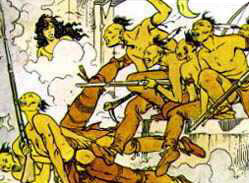 Indians have "nothing human except the shape," Washington wrote: "...the gradual extension of our settlements will as certainly cause the savage, as the wolf, to retire; both being beasts of prey, tho' they differ in shape."
Indians have "nothing human except the shape," Washington wrote: "...the gradual extension of our settlements will as certainly cause the savage, as the wolf, to retire; both being beasts of prey, tho' they differ in shape."
Francis Jennings, Empire of Fortune, 62; Richard Drinnon, Facing West, 65, citing a Washington letter of 1783
Indians received not only similar descriptions to those given predatory animals, but much the same treatment as well. George Washington, revered as the father of the country, wrote that Indians "...were wolves and beasts who deserved nothing from the whites but 'total ruin'" (Stannard, p. 241). Thomas Jefferson, acclaimed proponent of freedom and democracy, argued that the United States government was obliged "...to pursue [Indians] to extermination, or drive them to new seats beyond our reach" (quoted in Takaki, 1979, p. 103). Andrew Jackson, founder of the modern Democratic Party and greatest Indian killer of all American Presidents, urged United States troops "...to root out from their 'dens' and kill Indian women and their 'whelps'" (Stannard, p. 240).
David Rider, "Indians" and Animals: A Comparative Essay
More on our wacky Founding Fathers and their involvement with Indians
Discovery gave title to the government by whose subjects...it was made, against all other European governments, which title might be consummated by possession....[D]iscovery gave an exclusive right to extinguish the Indian title of occupancy, either by purchase or by conquest...the Indians were fierce savages...whose subsistence was drawn chiefly from the forest. To leave them in possession of their country, was to leave the country a wilderness.
Supreme Court, Johnson v. McIntosh, 21 US 543, 1823, pgs. 573, 587, 590
Humanity has often wept over the fate of the aborigines of this country, and Philanthropy has been long busily employed in devising means to avert it, but its progress has never for a moment been arrested, and one by one have many powerful tribes disappeared from the earth. To follow to the tomb the last of his race and to tread on the graves of extinct nations excite melancholy reflections. But true philanthropy reconciles the mind to these vicissitudes as it does to the extinction of one generation to make room for another. In the monuments and fortresses of an unknown people, spread over the extensive regions of the West, we behold the memorials of a once powerful race, which was exterminated or has disappeared to make room for the existing savage tribes. Nor is there anything in this which, upon a comprehensive view of the general interests of the human race, is to be regretted. Philanthropy could not wish to see this continent restored to the conditions in which it was found by our forefathers. What good man would prefer a country covered with forests and ranged by a few thousand savages to our extensive Republic, studded with cities, towns, and prosperous farms, embellished with all the improvements which art can devise or industry execute, occupied by more than 12,000,000 happy people, and filled with all the blessings of liberty, civilization, and religion?
Andrew Jackson, First Annual Message to Congress, December 8, 1830
Intelligence, activity, ambition, progression, high anatomical development, characterize some races; stupidity, indolence, immobility, savagism, low anatomical development characterize others. Lofty civilization, in all cases, has been achieved solely by the 'Caucasian' group. Mongoloid races, save in the Chinese family, in no instance have reached beyond the degree of semi-civilization; while the Black races of Africa and Oceanica no less than the Barbarous tribes of America have remained in utter darkness for thousands of years. ... The Barbarous races of America (excluding the Toltecs) although nearly as low in intellect as the Negro races are essentially untameable [sic]. Not merely have all attempts to civilize them failed, but also every endeavor to enslave them. Our Indian tribes submit to extermination, rather than wear the yoke under which our Negro slaves fatten and multiply. ... The pure-blooded savage still skulks untamed through the forest, or gallops athwart the prairie. Can any one call the name of a single pure Indian of the Barbarous tribes who—except in death, like a wild cat—has done anything worthy of remembrance?
Josiah C. Nott, "Types of Mankind: Or, Ethnological Researches," 1854
 Returning to America, the famed Harvard physician and social commentator Oliver Wendell Holmes observed in 1855 that Indians were nothing more than a "half-filled outline of humanity" whose "extermination" was the necessary "solution of the problem of his relation to the white race." Describing native peoples as "a sketch in red crayons of a rudimental manhood," he added that it was only natural for the white man to "hate" the Indian and to "hunt him down like the wild beasts of the forest, and so the red-crayon sketch is rubbed out, and the canvas is ready for a picture of manhood a little more like God's own image."
Returning to America, the famed Harvard physician and social commentator Oliver Wendell Holmes observed in 1855 that Indians were nothing more than a "half-filled outline of humanity" whose "extermination" was the necessary "solution of the problem of his relation to the white race." Describing native peoples as "a sketch in red crayons of a rudimental manhood," he added that it was only natural for the white man to "hate" the Indian and to "hunt him down like the wild beasts of the forest, and so the red-crayon sketch is rubbed out, and the canvas is ready for a picture of manhood a little more like God's own image."
David Stannard, American Holocaust: The Conquest of the New World
But the Indians are children. Their arts, wars, treaties, alliances, habitations, crafts, properties, commerce, comforts, all belong to the very lowest and rudest ages of human existence. Some few of the chiefs have a narrow and short-sighted shrewdness, and very rarely in their history, a really great man, like Pontiac or Tecumseh, has arisen among them; but this does not shake the general truth that they are utterly incompetent to cope in any way with the European or Caucasian race. Any band of schoolboys, from ten to fifteen years of age, are quite as capable of ruling their appetites, devising and upholding a public policy, constituting and conducting a state or community, as an average Indian tribe. And, unless they shall be treated as a truly Christian community would treat a band of orphan children providentially thrown on its hands, the aborigines of this country will be practically extinct within the next fifty years.
I have learned to appreciate better than hitherto, and to make more allowance for, the dislike, aversion, contempt wherewith Indians are usually regarded by their white neighbors, and have been since the days of the Puritans. It needs but little familiarity with the actual, palpable aborigines to convince anyone that the poetic Indian—the Indian of Cooper and Longfellow—is only visible to the poet's eye. To the prosaic observer, the average Indian of the woods and prairies is a being who does little credit to human nature—a slave of appetite and sloth, never emancipated from the tyranny of one animal passion save by the more ravenous demands of another.
Horace Greeley, Letter 13: Lo! the Poor Indian!, An Overland Journey, from New York to San Francisco, in the Summer of 1859, 1860
The Congress of the Confederate states has passed a law declaring extermination to all hostile Indians. You will therefore use all means to persuade the Apaches or any tribe to come in for the purpose of making peace, and when you get them together kill all the grown Indians and take the children prisoner and sell them to defray the expense of killing the Indians. Buy whiskey....for the Indians and I will order vouchers given to recover the amount expended. Have a sufficient number of men around to allow no Indian to escape....I look to you for success against these cursed pests.
John R. Baylor, Confederate governor of Arizona, order to Capt. Helms, commander of the Arizona Guards, March 1862
If the savage resists, civilization, with the Ten Commandments in one hand and the sword in the other, demands his immediate execution.
Andrew Johnson, message to Congress, 1867
The idea that a handful of wild, half-naked, thieving, plundering, murdering savages should be dignified with the sovereign attributes of nations, enter into solemn treaties, and claim a country 500 miles wide by 1,000 miles long as theirs in fee simple, because they hunted buffalo or antelope over it, might do for a beautiful reading of Hiawatha, but is unsuited to the intelligence and justice of this age, or the natural rights of mankind.
New Mexico Supreme Court, United States v. Lucero, 1 NM S. Ct. 422, 1869
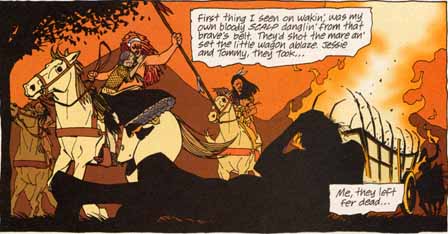
He is ignoble—base and treacherous, and hateful in every way. Not even imminent death can startle him into a spasm of virtue. The ruling trait of all savages is a greedy and consuming selfishness, and in our Noble Red Man it is found in its amplest development. His heart is a cesspool of falsehood, of treachery, and of low and devilish instincts. With him, gratitude is an unknown emotion; and when one does him a kindness, it is safest to keep the face toward him, lest the reward be an arrow in the back. To accept of a favor from him is to assume a debt which you can never repay to his satisfaction, though you bankrupt yourself trying. To give him a dinner when he is starving, is to precipitate the whole hungry tribe upon your hospitality, for he will go straight and fetch them, men, women, children, and dogs, and these they will huddle patiently around your door, or flatten their noses against your window, day after day, gazing beseechingly upon every mouthful you take, and unconsciously swallowing when you swallow! The scum of the earth!
All history and honest observation will show that the Red Man is a skulking coward and a windy braggart, who strikes without warning—usually from an ambush or under cover of night, and nearly always bringing a force of about five or six to one against his enemy; kills helpless women and little children, and massacres the men in their beds; and then brags about it as long as he lives, and his son and his grandson and great-grandson after him glorify it among the "heroic deeds of their ancestors."
Mark Twain, The Noble Red Man, 1870
In 1871 Francis A. Walker, Commissioner of Indian Affairs, considered Indians beneath morality: "When dealing with savage men, as with savage beasts, no question of national honor can arise."
James W. Loewen, Lies My Teacher Told Me
Two decades later, on the occasion of the nation's 1876 centennial celebration, the country's leading literary intellectual took time out in an essay expressing his "thrill of patriotic pride" flatly to advocate "the extermination of the red savages of the plains." Wrote William Dean Howells to the influential readers of the Atlantic Monthly:
The red man, as he appears in effigy and in photograph in this collection [at the Philadelphia Centennial Exposition], is a hideous demon, whose malign traits can hardly inspire any emotion softer than abhorrence. In blaming our Indian agents for malfeasance in office, perhaps we do not sufficiently account for the demoralizing influence of merely beholding those false and pitiless savage faces; moldy flour and corrupt beef must seem altogether too good for them.
David Stannard, American Holocaust: The Conquest of the New World

"We are not going to let a few thieving, ragged Indians stop and check the progress of the railroad," [General Sherman] wrote to General Grant in 1867 (Fellman, p. 264). As Fellman writes:
[T]he great triumvirate of the Union Civil War effort [Grant, Sherman and Sheridan] formulated and enacted military Indian policy until reaching, by the 1880s, what Sherman sometimes referred to as "the final solution of the Indian problem," which he defined as killing hostile Indians and segregating their pauperized survivors in remote places . . . . These men applied their shared ruthlessness, born of their Civil War experiences, against a people all three despised, in the name of Civilization and Progress (emphasis added).
Thomas J. DiLorenzo, How Lincoln's Army 'Liberated' the Indians
I suppose I should be ashamed to say that I take the Western view of the Indian. I don't go so far as to think that the only good Indians are dead Indians, but I believe nine out of every ten are, and I shouldn't like to inquire too closely into the case of the tenth. The most vicious cowboy has more moral principle than the average Indian. Turn three hundred low families of New York into New Jersey, support them for fifty years in vicious idleness, and you will have some idea of what the Indians are. Reckless, revengeful, fiendishly cruel, they rob and murder, not the cowboys, who can take care of themselves, but the defenseless, lone settlers on the plains. As for the soldiers, an Indian chief once asked Sheridan for a cannon. "What! Do you want to kill my soldiers with it?" asked the general. "No," replied the chief, "want to kill the cowboy; kill soldier with a club."
Theodore Roosevelt, speech, January 1886
The PIONEER has before declared that our only safety depends upon the total extirmination [sic] of the Indians. Having wronged them for centuries we had better, in order to protect our civilization, follow it up by one more wrong and wipe these untamed and untamable creatures from the face of the earth.
L. Frank (Wizard of Oz) Baum, Aberdeen Saturday Pioneer, January 3, 1891
All men of sane and wholesome thought must dismiss with impatient contempt the plea that these continents should be reserved for the use of scattered savage tribes, whose life was but a few degrees less meaningless, squalid, and ferocious than that of the wild beasts with whom they held joint ownership. It is as idle to apply to savages the rules of international morality which obtain between stable and cultured communities, as it would be to judge the fifth-century English conquest of Britain by the standards of today.
Theodore Roosevelt, The Winning of the West, Volume Three: The Founding of the Trans-Alleghany Commonwealths, 1784-1790, 1894

On the trail of the pirates, stealing noiselessly down the war-path, which is not visible to inexperienced eyes, come the redskins, every one of them with his eyes peeled. They carry tomahawks and knives, and their naked bodies gleam with paint and oil. Strung around them are scalps, of boys as well as of pirates, for these are the Piccaninny tribe, and not to be confused with the softer-hearted Delawares or the Hurons.
J. M. Barrie, Chapter 5 -- The Island Come True, The Adventures of Peter Pan, 1911 (first prose publication)
More bad
Lest anyone think these examples of "savage-bashing" are ancient history, here are some of the many modern examples:
"I am a Sioux. At heart I am a savage." He waved a hand around. "This forest? Do you think it strange to me? The forest is my home. I am a part of it, just as are the tiger, the bear, and the wolf. I belong there and have always known it."
.
.
.
He was a Sioux, and for the Sioux as for most Indians war had been a way of life. More than one Indian had said that without war they could not exist.
Louis L'Amour, Last of the Breed, 1986
The American Indians were meaner to themselves than anybody was ever mean to them. The people were savages. It's true, they damn well were … these people were out there destroying timber, they were out there conquering and killing each other, scalping people.
Rush Limbaugh, quoted in Bigotshtick: Rush Limbaugh on Indians, 1995
"The Wild Frontier" concentrates on the warlike, cruel and revengeful elements of this description, especially the cruelty. It is one long catalog of the raids, murders and tortures committed by the Indians as the invading Europeans relentlessly pushed them west from the Atlantic Coast, west from the Mississippi valley and eventually out of California. Osborn dwells on this in wearying detail. Over and over, for page after page after page, he describes Indians scalping, burning and mutilating their captives.
Anthony Day, One-Sided Take on the Old West, LA Times, 1/12/01
as far as i am concerned there were no wrongs done to native americans..unlike your knee-jerk liberals (emphasis on "jerk") wish that it were true but really wasn't an interpretaion of history...THEY WERE SAVAGES!!!!!!
E-mail from a history professor, Mass. College of Liberal Arts, c. March 2001
Attacks on the remote Ranches and Farms have created panic in Cowtown. Indian raiders have been stealing livestock and burning homes. The Savages are probably disgruntled Indians from the Reservation. What exactly has motivated this return to the warpath is not clear. Residents of the Cowtown are expecting the preparing for a possible attack.
Church flyer for a Bible school barbeque in Michigan, c. August 2001
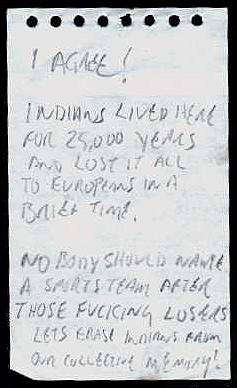
Me and my two sons, age 1 1/2 and 4, went shopping for school clothes. When we paid for our purchase, a woman came up to us and asked why it was that we hadn't paid tax while she had to.
I explained to the woman that my husband was First Nation and that the merchandise would be delivered on the reserve.
The woman then turned toward my two sons and said f------ savage.
Nancy Larry, letter, Miramichi Leader, posted 9/7/01
After listening to her sob uncontrollably for an hour and a half, Barry Landeros-Thomas finally calmed his daughter down enough for her to explain to him why she came home from school in tears.
During recess, a couple of boys danced around her singing a Pocahontas song, "Savages! Savages! Barely even human," he said.
"Native Americans Face Stereotypes," The Post (Ohio University), 11/1/01
Call me savage!
David A. Yeagley (Comanche), Make More Indian Warrior Images, Grand Forks Herald, 12/2/01
The Yanomami tribe of the Amazon rainforest were branded 'the meanest people on the planet' in a racist insult broadcast on the BBC this morning.
Miriam Ross, Survival International news release, 5/29/02
Move to the reservation you drunk. Do you enjoy the casino money? You lost the land to a more intelligent being (human). Go Redskins
Note left on an AIM supporter's truck in Kentucky, 7/5/02
In point of fact, the Europeans who discovered America brought advanced civilization to a savage, vicious, animalistic New World. The Natives who inhabited the Americas were brutal thugs waging constant wars and engaging in widespread scalping. Their economies were primitive with little incentive for technological innovation. A three-course meal consisted of maize, tree bark, and human flesh.
Joseph J. Sabia, Cornell Leftists Trash Columbus/America, Front Page Magazine, 10/14/02
Though I don't know enough Thai to catch all the nuances of "Drunk Man Cowboy and his Gang", I'm soon convinced that I've stumbled upon the single most politically incorrect depiction of Western life ever performed in public. Indeed, after less than a minute of narrative back-story, the whole production erupts into a paroxysm of violence: Thai cowboys in Lone Ranger masks rush out to slap squaws, lasso braves, chug beers, and shoot off their six-guns; grease-painted Indians whoop, slash scalps, guzzle whiskey, and brandish spears. Fists fly, tables are overturned, and (in what I presume is the "stunt" portion of the show) several combatants are hurled bodily into buildings and fence-posts.
.
.
.
Eventually, the brawl makes its way back up onto the stage, where the evening's entertainment ends with a surprise Indian triumph. The audience is handed flaming bamboo torches and invited to join the Indians in whooping around a bonfire, and — not wanting to be a killjoy — I join in on the action.
Rolf Potts, Cowboys and Indians, Thai-Style, 8/7/03
Prior to 1492, what is now the United States was sparsely inhabited, unused, and undeveloped. The inhabitants were primarily hunter-gatherers, wandering across the land, living from hand-to-mouth and from day-to-day. There was virtually no change, no growth for thousands of years. With rare exception, life was nasty, brutish, and short: there was no wheel, no written language, no division of labor, little agriculture and scant permanent settlement; but there were endless, bloody wars.
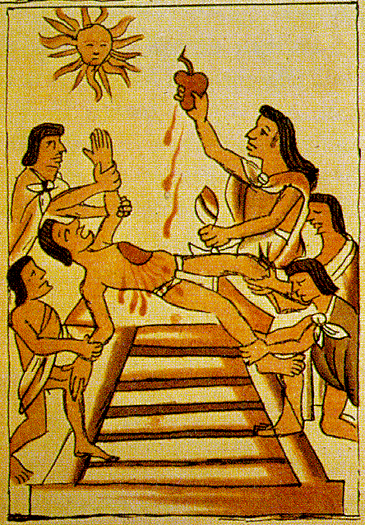
Michael Berliner, On Columbus Day, Celebrate Western Civilization, Not Multiculturalism, 10/13/03
Every American has heard the story of how Indians were conquered and robbed of their land by settlers from Europe. Less often told are stories of how, before Europeans came to the Americas, Indian tribes had been conquering and robbing each other constantly in the same ways. European "tribes", if you will, could not out do Indian tribes for cruelty and savagery. Indians were fully as nasty to one another as Europeans were to them.
Tom McLaughlin, Indians and Casinos, The Conway Daily Sun, 10/30/03
More pix of "savage" Indians
Magua (from Last of the Mohicans)
"Massacre of the Whites by the Indians and Blacks in Florida"
Indians attacking a covered wagon
"Sauvauge du No. de la Louisiane" (scalper)
[M]y college students still come up with savage when I ask them for five adjectives that apply to Indians. Like much of our "knowledge" about Native Americans, the "savage" stereotype comes particularly from Western movies and novels, such as the popular "Wagons West" series by Dana Fuller Ross. These paperbacks, which have sold hundreds of thousands of copies, claim boldly, "The general outlines of history have been faithfully followed." Titled with state names—Idaho!, Utah!, etc.—the novels' covers warn that "marauding Indian bands are spreading murder and mayhem among terror-stricken settlers." In the Hollywood Old West, wagon trains are invariably encircled by savage Indian hordes. In the real West, among 250,000 whites and blacks who journeyed across the Plains between 1840 and 1860, only 362 pioneers (and 426 Native Americans) died in all the recorded battles between the two groups. Much more commonly, Indians gave the new settlers directions, showed them water holes, sold them food and horses, bought cloth and guns, and served as guides and interpreters. These activities are rarely depicted in movies, novels, or our textbooks. Inhaling the misinformation of the popular culture, students have no idea that Natives considered European warfare far more savage than their own.
New England's first Indian war, the Pequot War of 1636-37, provides a case study of the intensified warfare Europeans brought to America. Allied with the Narragansetts, traditional enemies of the Pequots, the colonists attacked at dawn. Surrounding the Pequot village, whose inhabitants were mostly women, children, and old men, the British set it on fire and shot those who tried to escape the flames. William Bradford described the scene: "It was a fearful sight to see them thus frying in the fire and the streams of blood quenching the same, and horrible was the stink and scent thereof; but the victory seemed a sweet sacrifice, and they gave praise thereof to God, who had wrought so wonderfully for them." The slaughter shocked the Narragansetts, who had wanted merely to subjugate the Pequots, not exterminate them. The Narragansetts reproached the English for their style of warfare, saying, "It is naught, it is naught, because it is too furious, and slays too many men." In turn, Capt. John Underhill scoffed, saying that the Narragansett style of fighting was "more for pastime, than to conquer and subdue enemies." Underhill's analysis of the role of warfare in Narragansett society was correct, and might accurately be applied to other tribes as well. Through the centuries, whites frequently accused their Native allies of not fighting hard enough.
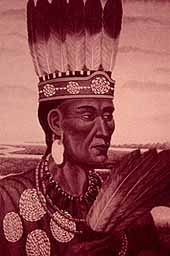
James W. Loewen, Lies My Teacher Told Me
The declaration of war was of course different between the Christians and Indians. The former would just ride in and start their Godly massacre, while the Indians generally informed their opposition of the impending battle. As one Chief told the Christian settlers,
We are minded to live at peace. If we intend at any time to make war upon you, we will let you know of it, and the reasons why we make war with you; and if you make us satisfaction for the injury done us, for which the war is intended, then we will not make war on you. And if you intend at any time to make war with us, we would have you let us know of it and the reasons for which you make war on us, and then if we do not make satisfaction, for the injury done unto you, then you may make war on us, otherwise, you ought not to do it.
In battle, to Indians war was a demonstration of bravery. One who fought hand to hand was looked on as the most brave and one who fought from a distance with bow and arrows cowardly. War was a symbolic ascendancy ritual as opposed to [the] complete dominion the Christians pursued. Indians would leap and dance ceremoniously on the battle field...[they] contained the confrontation between warriors and did not involve women and children as did the Christians, per their scriptures.
Dave Fisher, "The Christian Invasion of North America by the English"
Commenting on indigenous warfare, anthropologist Stanley Diamond has noted that to people such as the American Indians "taking a life was an occasion," whereas warfare of the type described "is a kind of play. No matter what the occasion for hostility, it is particularized, personalized, ritualized." In contrast, by the time of the invasion of the Americas, European warfare had long since been made over into what Diamond describes as "an abstract, ideological compulsion" resulting in "indiscriminate, casual, unceremonious killing."
David Stannard, American Holocaust: The Conquest of the New World
Savages we call them, because their manners differ from ours, which we think the Perfection of Civility; they think the same of theirs. . . . Perhaps, if we could examine the Manners of different Nations with Impartiality, we should find no People so rude, as to be without any Rules of Politeness; nor any so polite, as not to have some Remains of Rudeness.
Benjamin Franklin, "Remarks Concerning the Savages of North America," 1784
When a white man kills an Indian in a fair fight it is called honorable, but when an Indian kills a white man in a fair fight it is called murder. When a white army battles Indians and wins it is called a great victory, but if they lose it is called a massacre and bigger armies are raised. If the Indian flees before the advance of such armies, when he tries to return he finds that white men are living where he lived. If he tries to fight off such armies, he is killed and the land it taken anyway. When an Indian is killed it is a great loss which leaves a gap in our people and a sorrow in our heart; when a white is killed, three or four others step up to take his place and there is no end to it.
Chiksika (Kispokotha Shawnee), elder brother of Tecumseh, speaking to Tecumseh, March 19, 1779
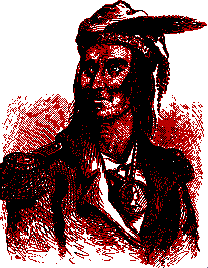
Above all whose history is fully known, Tecumseh was the ideal noble Redman realized; nevertheless, he was not alone; Wabasha, Osceola, Kanakuk, and Wovoka must be numbered among those whose great hearts reached out in kindness even to those who hated them.
Tecumseh taught, "Love your enemy after he is conquered"; Kanakuk preached non-resistance to evil; Wovoka, "Be kind to all men."
Ernest Thompson Seton, "Chapter II: The Spartans of the West," The Book of Woodcraft, 1912
You know the cause of our making war. It is known to all white men. They ought to be ashamed of it. The white men despise the Indians, and drive them from their homes. But the Indians are not deceitful. The white men speak bad of the Indian, and look at him spitefully. But the Indian does not tell lies; Indians do not steal.
An Indian, who is as bad as the white men, could not live in our nation; he would be put to death, and eat up by the wolves. The white men are bad schoolmasters; they carry false looks, and deal in false actions; they smile in the face of the poor Indian to cheat him; they shake them by the hand to gain their confidence, to make them drunk, to deceive them, and ruin our wives.
Black Hawk (Sauk), surrender speech, 1832
How inhuman it was in those wretches to come into a country where nature shone in beauty, spreading her wings over the vast continent, sheltering beneath her shades those natural sons of an Almighty Being, that shone in grandeur and lustre like stars of the first magnitude in the heavenly world; whose virtues far surpassed their more enlightened foes, notwithstanding their pretended zeal for religion and virtue. How they could go to work to enslave a free people, and call it religion, is beyond the power of my imagination, and out-strips the revelation of God's world. Oh, thou pretended hypocritical Christian, whoever thou art, to say it was the design of God, that we should murder and slay one another, because we have the power.
William Apess (Pequot), January 6, 1836
Finally, let me reproduce in full the account by Bonneville, from which I have already selected portions. In 1834, he visited the Nez Perces and Flatheads, and thus sums up these wholly primitive Indians, for they were as yet uncorrupted by the whiskey-trader or those who preached the love of money.
They were friendly in their dispositions, honest to the most scrupulous degree in their intercourse with the white man. (P. 200.) Simply to call these people religious would convey but a faint idea of the deep hue of piety and devotion which pervades their whole conduct. Their honesty is immaculate, and their purity of purpose and their observance of the rites of their religion are most uniform and remarkable. They are certainly more like a nation of saints than a horde of savages. (Captain Bonneville's Narrative; by Washington Irving, p. 171, 1837.)
Ernest Thompson Seton, "Chapter II: The Spartans of the West," The Book of Woodcraft, 1912
All history of the subject goes to prove that, when first visited by civilized people, the American Indians have been found friendly and hospitable—from the days of Christopher Columbus to the Lewis and Clark Expedition...and so also have a great many others travelers, including myself. Nowhere, to my knowledge, have they stolen a six-pence worth of my property, though in their countries there are no laws to punish for theft. I have visited forty-eight different tribes, and I feel authorized to say that the North American Indian in his native state is honest, faithful, brave...and an honorable and religious being.
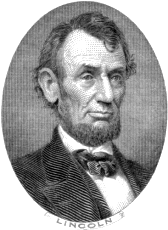
George Catlin, 1841
In 1863 President Lincoln at a conference with Native leaders from the Southern Plains presented the leaders with Presidential Peace Medals. Attempting to persuade the Native leaders of the superiority of White society he lectured them with the words, "We are not as a race so much disposed to fight and kill one another as our Red Brethren." Certainly these words must have bewildered the Native leaders as they were aware that over 300,000 men had died in the Civil War up to that point in time and another 300,000 would die before Lincoln himself was assassinated.
Mike Kohr, Your Heroes Are Not Our Heroes
[The rights of the Indians had been] assailed by the rapacity of the white man....The border white man's connection with the Indians [was] a sickening record of murder, outrage, robbery, and wrongs committed by the former as the rule.
1869 Board of Indian Commissioners Annual Report 10
The history of the Government connections with the Indians is a shameful record of broken treaties and unfulfilled promises. The history of the border white man's connection with the Indians is a sickening record of murder, outrage, robbery, and wrongs committed by the former, as the rule, and occasional savage outbreaks and unspeakably barbarous deeds of retaliation by the latter, as the exception.
Taught by the Government that they had rights entitled to respect, when those rights have been assailed by the rapacity of the white man, the arm which should have been raised to protect them has ever been ready to sustain the aggressor.
The testimony of some of the highest military officers of the United States is on record to the effect that, in our Indian wars, almost without exception, the first aggressions have been made by the white man....Every crime committed by a white man against an Indian is concealed and palliated. Every offense committed by an Indian against a white man is borne on the wings of the post or the telegraph to the remotest corner of the land, clothed with all the horrors which the reality or imagination can throw around it. Against such influences as these are the people of the United States need to be warned.
Helen Hunt Jackson, A Century of Dishonor, 1881
[Newspaper reports] have caused an unnecessary alarm among settlers in the vicinity, who have fled from their homes panic-stricken to places of supposed safety on false rumors that the Indians had broken out.
Letter from James McLaughlin, US Indian Agent, to T.J. Morgan, Commission on Indian Affairs, Nov. 29, 1890, quoted in the 1891 Commission on Indian Affairs Annual Report
It was terrible and horrible sight to see women and children lie in groups, dead. I suppose they were of one family. Some of the young girls wrapped their heads with shawls and buried their faces with their hands. I suppose they did that so they would not see the soldiers come up to shoot them. At one place there were 2 little children, one about 1 year old the other about 3, lying on their faces, dead; and about 30 yards from them a woman lay on her face, dead. These were away from the camp about an eighth of a mile.
Charles Eastman, physician at Pine Ridge during the Wounded Knee Massacre, in a letter to the Bureau of Indian Commissioners, Jan. 3, 1891, printed in the 1890 Commission on Indian Affairs Annual Report
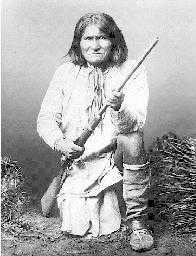
[V]ery many, and it might be said nearly all reports of hostile demonstrations of the Indians, the raiding of ranches, and the driving off of stock, have been without foundation; in fact, the Indians alone have been the sufferers so for [sic] as relates to the Cheyenne River reserve, and the parties doing the damage are believed to be white men.
Perain Palmer, Cheyenne River Agency, Aug. 17, 1891, quoted by John Rhodes in the 52 Montana Law Review 13, 1991
But how much less cruel [the Indian] was than the leaders of the Christian Church in the Middle Ages! What Indian massacre will compare in horror with that of St. Bartholomew's Eve or the Massacre of Glencoe? Read the records of the Inquisition, or the Queen Mary persecutions in England, or the later James II abominations for further light!
There was no torture used by the Indians that was not also used by the Spaniards. Every frontiersman of the Indian days knows that in every outbreak the whites were the aggressors; and that in every evil count—robbery, torture and massacre—they did exactly as the Indians did. "The ferocity of the Redman," says Bourke, "has been more than equaled by the ferocity of the Christian Caucasian." (On the Border with Crook, 114)
There are good grounds for stating that the Indians were cruel to their enemies, but it is surprising to see how little of this cruelty there was in primitive days. In most cases the enemy was killed in battle or adopted into the tribe; very, very rarely was he tortured. Captain Clark says of the Cheyennes:
"There is no good evidence that captives have been burned at the stake, flayed alive, or any other excruciating torture inflicted on persons captured by these fierce, war loving and enterprising barbarians." (Sign Language)
But we know now that the whites did use diabolical tortures in their dealings with the Indian, and deliberately and persistently misrepresented him in order to justify their own atrocities.
The whites, however, had print to state their case, while the Indians had none to tell their story or defend them. Furthermore, it is notorious that all massacres of Indians by the whites were accomplished by treachery in times of peace, while all Indian massacres of whites were in time of war, to resist invasion. At present, I know of no exception to this rule. (Many supposed massacres by Indians are now known to have been the work of whites disguised as Indians.)
Ernest Thompson Seton, "Chapter II: The Spartans of the West," The Book of Woodcraft, 1912
Here are the simple facts of the long struggle between the two races:
There cannot be the slightest doubt that the Indian was crushed only by force of superior numbers. And had the tribes been united even, they might possibly have owned America today.
Finally, a famous Indian fighter of the most desperate period thus summarizes the situation and the character of the dispossessed:
History can show no parallel to the heroism and fortitude of the American Indians in the two hundred years' fight during which they contested inch by inch the possession of their country against a foe infinitely better equipped, with inexhaustible resources, and in overwhelming numbers. Had they even been equal in numbers, history might have had a very different story to tell. (Gen. Nelson A. Miles, U. S. A., Letter, February x6, 1912.)
I never yet knew a man who studied the Indians or lived among them, without becoming their warm friend and ardent admirer. Professor C. A. Nichols, of the Southwestern University, a deep student of Indian life, said to me, sadly, one day last autumn:
I am afraid we have stamped out a system that was producing men who, taken all around, were better than ourselves.
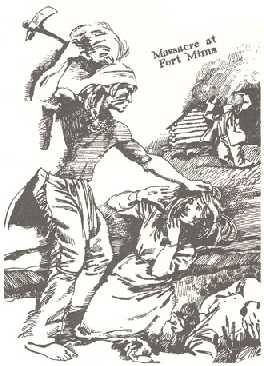
Our soldiers, above all others, have been trained to hate the Redmen, and yet the evidence of those that have lived years with this primitive people is, to the same effect as that of missionaries and travelers, namely, that the high-class Indian was brave; he was obedient to authority. He was kind, clean and reverent. He was provident, unsordid; hospitable, dignified, courteous, truthful, and honest. He was the soul of honor. He lived a life of temperance and physical culture that he might perfect his body, and so he achieved a splendid physique. He was a wonderful hunter, a master of woodcraft, and a model for outdoor life in this country. He was heroic and picturesque all the time. He knew nothing of the forgiveness of sin, but he remembered his Creator all the days of his life, and was in truth one of the finest types of men the world has ever known.
Ernest Thompson Seton, "Chapter II: The Spartans of the West," The Book of Woodcraft, 1912
[A picture similar to this one] shows a motif common in nineteenth-century lithographs: Indians invading the sanctity of the white settlers' homes. Actually, whites were invading Indian lands and often Indian homes, but pictures such as this, not the reality, remain the archetype.
James W. Loewen, Lies My Teacher Told Me
"The American Indians were meaner to themselves than anybody was ever mean to them."
This is the basic stereotype on Indians: a war-like nature. Limbaugh is starting by harping on this one. Watch him run with it again and again. It has just enough reality in it to make it useful. For instance, it is true that Indians warred, and that during wartime people sometimes acted with meanness and brutality. You won't hear from Limbaugh, however, how the damage inflicted in traditional Indian disputes pales in comparison to the mass exterminations carried out against tribes, or by nation-states against tribes, or by nation-states against civilian populations. It is a cheap stereotype. A trick.
"The people were savages. It's true, they damn well were … scalping people."
This is a deepening of the stereotype, deceitful and manipulative, not only for what it says, but for what it hides and obfuscates.
By focusing on the "war-like" Indian image, by invoking the designation of "savage," the far more prevalent philosophies of Native American societies -- governmental and spiritual application -- the documented reality of Native American knowledge systems is completely left out of the listeners' perceptions. This reflects the Limbaugh style: over hours and hours each week, only negative images are reinforced of anyone Limbaugh perceives to be an enemy.
Jose Barreiro, Bigotshtick: Rush Limbaugh on Indians, Native Americas Journal, Fall 1995
What we see here is a subconscious attempt to manipulate the world in order to make it conform to the English definition of it. The evidence also suggests that the English stereotype of the hostile savage helped assuage a sense of guilt which inevitably arose when men whose culture was based on the concept of private property embarked on a program to dispossess another people of their land. To type-cast the Indian as a brutish savage was to solve a moral dilemma. If the Indian was truly cordial, generous, and eager to trade, what justification could there be for taking his land? But if he was a savage, without religion or culture, perhaps the colonists' actions were defensible. The English, we might speculate, anticipated hostility and then read it into the Indian's character because they recognized that they were embarking upon an invasion of land to which the only natural response could be violent resistance. Having created the conditions in which the Indian could only respond violently, the Englishman defined the native as brutal, beastly, savage, and barbarian and then used that as a justification for what he was doing.
Gary B. Nash, Red, White, and Black: The Origins of Racism in Colonial America
Historians might question who was hostile first, but on the landscape from sea to shining sea the victors got to apply terms like "aggression," "hostile," and "menace" to Indian behavior. The result of all this bad history is that Americans today simply do not understand the texture of white violence that Native Americans living on the border of white control had to endure.
James W. Loewen, Lies Across America
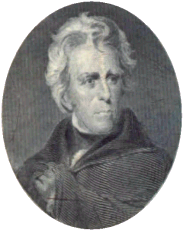
And the ugly
[Andrew] Jackson was so effective at rooting women and "whelps" from their "dens," he adopted the habit of cutting off his victims' noses as trophies to commemorate his exploits. He earned the name "Sharp Knife" from Creek Indians for his penchant for skinning victims and using the cured and braided tissue as reins for his ponies (Takaki, 1994).
David Rider, "Indians" and Animals: A Comparative Essay
The Indian men . . . are to be killed whenever and wherever you can find them: the women and children will not be harmed, but you will take them prisoners. . . .If the Indians send in a flag and desire to treat for peace, say to the bearer; [they have broken] their treaty of peace, and murdered innocent people and run off their stock: that now we are going to punish them for their crimes, and that you are there to kill them wherever they can be found. We have no faith in their broken promises and we intend to kill enough of their men to teach them a lesson.
I trust that this severity in the long run will be the most humane course that could be pursued toward these Indians.
Instructions to Colonel Kit Carson from General James H. Carleton when Carson was placed in charge of removing the Navajo from their homeland, 1864—quoted in New Mexico, A History of Four Centuries by Warren A. Beck, p. 189
...[T]he U.S. annexed the Philippines in 1899 and waged a brutal war to enforce its rule across the archipelago. Nearly 5,000 American soldiers died, and historians estimate that 250,000 Filipinos perished — 20,000 were killed in combat and the vast majority died from disease and starvation. The U.S. Army burned villages and fields, massacred civilians and herded the residents of entire provinces into concentration camps.
The U.S. justified this inhumane treatment by calling Filipinos uncivilized and incapable of governing themselves. American soldiers in the Philippines, many of whom had fought Indian wars in the U.S. West, were the first to use the racist appellation "gook," which gained notoriety during the Vietnam War.
Amy Kaplan, Confusing Occupation With Liberation, LA Times, 10/24/03
Long ago, in the days before Jerry Springer and the World Wrestling Federation, people satisfied their baser need for entertainment with a trip to the town square to watch real-live heathens burned at the stake, witches drowned and traitors peppered with buckshot.
Cultures chose their instruments of torture carefully. The ancient Romans devised the cross. The French brought us the guillotine. And in the Old West, cowboys were partial to hangings at dawn.
While our predecessors considered them even-handed, these practices seem barbaric today. Yet a couple months ago, the U.S. attorney in Oklahoma City sent out 1,100 personalized invitations to Timothy J. McVeigh's execution.
Only 10 ringside seats were available in the death chamber in Terre Haute, Ind., for the invitation's recipients—survivors of the Oklahoma City bombing and victims' family members. But U.S. Atty. Gen. John Ashcroft approved the ultimate "reality" show for the rest: a closed-circuit telecast, in Oklahoma City, of McVeigh's execution.
Gabrielle Banks, "How Far Have We Come Since Hangings?," LA Times, 5/9/01
We want action. Any country or person harboring a known terrorist must face annihilation. Any person or country purposely contributing to terrorism must face extinction. It's simple. This is what American people need to hear.
David Yeagley (Comanche), Indians Should Lead the Way to War, Grand Forks Herald, 9/16/01
More on savage Indians
Red, White, and Black: The Origins of Racism in Colonial America
American Indian Stereotypes: 500 Years of Hate Crimes
Other minorities stereotyped as savages
Can Gramsci's Theory of Hegemony Help Us to Understand the Representation of Ethnic Minorities in Western Television and Cinema?
PanAfrica: Savage Beasts and Beastly Savages
Adventurer Africa (Theodore Roosevelt)
The Winning of the West: From the Alleghenies to the Mississippi 1769-1776: With Map (Theodore Roosevelt)
Irish Famine, Unit II: Racism
Japan in the U.S. Press: Bias and Stereotypes
One Palestine, Complete: Jews and Arabs Under the British Mandate--by Tom Segev
The Jew as Devil
Related links
Scalping, torture, and mutilation by Indians
Indians as cannibals
Uncivilized Indians
"Primitive" Indian religion
Native vs. non-Native Americans: a summary
|
. . . |

|
All material © copyright its original owners, except where noted.
Original text and pictures © copyright 2007 by Robert Schmidt.
Copyrighted material is posted under the Fair Use provision of the Copyright Act,
which allows copying for nonprofit educational uses including criticism and commentary.
Comments sent to the publisher become the property of Blue Corn Comics
and may be used in other postings without permission.